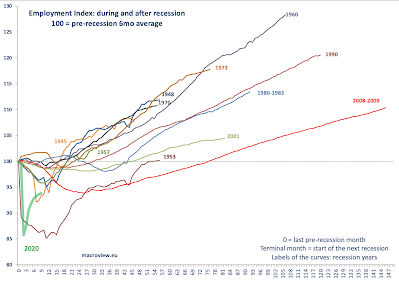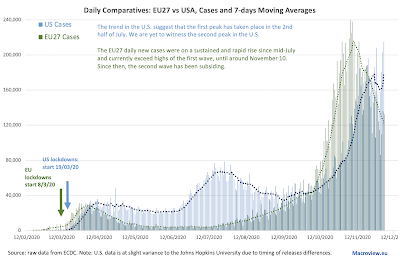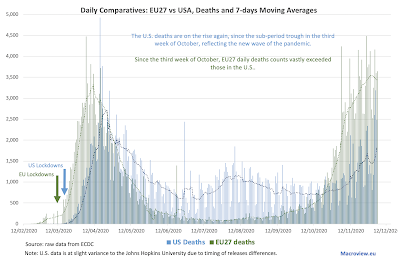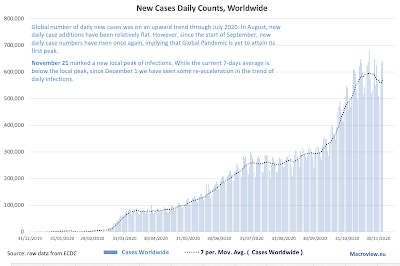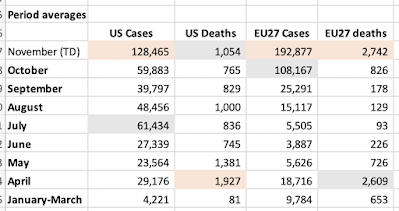My comment for Euromoney on changes in sovereign risk profile for Hungary: https://www.euromoneycountryrisk.com/article/b1pjjpq2xr2bfy/hungarys-risk-improvement-in-peril-as-it-bites-the-hand-that-feeds-it.
Saturday, December 12, 2020
Thursday, December 10, 2020
10/12/20: U.S. Labor Markets Update: America's Scariest Charts
Continued unemployment claims are running below the 2008 GFC peak for the third week in a row, but adjusting to pre-Covid19 cycle unemployment roughs, we are still ways to go:
- Latest weekly change in continued unemployment figures is an increase of 230,000 - the first rise in 13 weeks.
- Pre-Covid19 trough was at 1,702,000 continued claims. We are currently at 5,757,000.
- Compared to pre-recession 12 weeks low, current unemployment claims are 334% higher or more than 3.3 times higher.
- New claims are also rising: the latest confirmed data is a weekly increase of 23,977 - the largest in 5 weeks.
- The latest preliminary data shows new claims up +228,982 in the week of December 5th, based in States' data.
Saturday, December 5, 2020
4/12/20: COVID19 Update: U.S. vs EU27
EU27 vs U.S. comparatives for COVID19 pandemic to-date:
- The U.S. retains higher death rate per 1 million population (844.6), than the EU27 (624.4).
- Current U.S. death rate per capita is 35% above the EU27, though this gap is still closing (it was 42% a week ago).
- Gross counts of deaths in the U.S. >> the EU27 over 12/07 - 1/12. This was reversed on 2/12, with total EU27 deaths currently at 278,914 vs the U.S. 276,316.
- Adjusting deaths to account for a 1 week lag in the onset of pandemic in the U.S., relative to the EU27, current U.S. deaths are 21,435 above those in the EU27
- Adjusted for population and pandemic timing differences, the U.S. deaths are 77,048 above those in the EU27.
- While the EU27 led the U.S. in new deaths and case counts through 20/11, since then, the U.S. has retaken the lead in new cases counts.
- Daily deaths counts in the U.S. are now expected to start exceeding those in the EU27 once again.
4/12/20: COVID19 Update: Countries with > 100,000 cases
As of today, 67 countries around thee world have registered > 100,000 cases of COVID19. Here are the summary tables of core statistics covering these countries:
Summary stats:
U.S. mortality rate from COVID19 has moderated over the last two weeks, falling from 21.9 deaths per 1,000 cases to 19.54. For the EU27, mortality actually rose from 23.0 to 23.3.
Overall, the worst performing country across three metrics of cases per capita, deaths per capita and deaths per 1,000 cases is Belgium, followed by Peru and Spain. Italy ranks the fourth, Argentina the fifth and the UK ranks the 6th worst performer,
The U.S. ranks 7th worst and the EU27 ranks 21st worst.
24 countries have more than 500,000 cases and 14 have more than 1,000,000 cases. The U.S. is the only country with more than 10,000,000 cases at 14,139,703. The second largest number of cases is in India at 9,571,559. Brazil is the third with 6,487,084 cases. Only seven countries recorded more than 50,000 deaths so far, of which four recorded more than 100,000 deaths. The U.S. has the largest number of total COVID19-linked deaths in the world (276,316), followed by Brazil (175,270) and India (139,188).
4/12/20: COVID19 Update: Worldwide Cases and Deaths
Updating data for COVID19 pandemic worldwide:
- Wave 1 peaked around April 9th and the first trough took place around the end of April.
- Wave 2 started from the first days of May and peaked between August 1 and August 14.
- Wave 3 started from the second trough of August 27-29th and has (to-date) peaked around November 21.
- Wave 1: peaking around April 22 generated a post-peak trough around June 3 that is statistically significantly below the peak values. This defines a statistically valid wave.
- Wave 2: starting from around June 7 and peaking around August 13. This wave ended in a trough of September 22 which is not statistically significant at 95% confidence level. This means it is harder to call this a genuine wave.
- Wave 3: starting from around October 23 and currently still accelerating. There is zero doubt that this is a well-defined wave.
In summary, the pandemic continues to rage and it appears that much welcomed moderation in the new cases dynamics witnessed in the last week of November is unlikely to hold. Worse, within a week, we will be going into pre-holidays mode around the world and in the U.S. we will be also experiencing lagged cases uplifts due to Thanksgiving travel.
Stay safe everyone: December will be a hellish month.
Thursday, December 3, 2020
3/12/20: Ireland PMIs: November
Ireland PMIs are out for November and they show the impact of the re-amplification of COVID19 impacts on the economy.
Services PMI fell from 48.3 in October to 45.4 in November, the lowest reading in 5 months and the third consecutive monthly reading sub-50. The pandemic period average is now at 39.3.
Meanwhile, Manufacturing PMI rose from 50.3 in October to 52.2 in November, marking the second consecutive month of readings above 50.0 mark. Pandemic period average is now at 48.2.
Construction sector PMI (through mid-November) is at 48.6 - marking third consecutive month of sub-50 readings.
As the chart below illustrates, Manufacturing is the only sector that is providing growth momentum in the economy and much of that is down to multinationals. In services sector, activity of multinationals (which are doing well) is more than offset by continued declines in activities of domestic enterprises.
Sunday, November 29, 2020
29/11/20: Bubblishiousness
Illustrating FOMO and Bubblishiousness vs Reality: Tesla
Thursday, November 19, 2020
19/11/20: COVID19 Update: Nordics & Sweden
Updating comparatives for Nordic countries:
New cases are blowing up in Sweden and are now on the declining trend in the rest of the Nordics. Charts above are showing Nordic countries adjusted for population size differences to Sweden.
18/11/20: COVID19 Update: Russia
Updating pandemic data for Russia: some summary stats first
- Russian second wave has been associated with exactly matching dynamics in both cases and deaths without any substantial lags;
- Both cases and deaths are yet to show any signs of stabilization and peaking (which is distinct from the EU27 experience so far);
- The two effects combined suggest that Russian pandemic numbers are likely to continue to worsen into December.
18/11/20: COVID19 Update: U.S. vs EU27
Comparatives for the pandemic development across the EU27 vs U.S.:
Thanks to an absolutely savage second wave of the pandemic, EU27 is now closing the gap with the U.S. in terms of total deaths, both in absolute terms and in per capita terms:
- Deaths per capita: the U.S. has overtaken the EU27 since May 18, and the trend for the U.S. continued to be worse than that for the EU27 until early October.
- EU27 death rate per capita has effectively flattened-out at around 308 per 1 million prior to August 2, but has been rising once again since then (498.1 currently).
- U.S. deaths per capita continue to increase (760.1 currently).
- The U.S. & EU27 are in 3rd (U.S.) and 2nd (EU27) waves of infections. Since Oct 1st, EU27 cases have surpassed the U.S. on all but 3 days & deaths on all but 16 days
- Overall counts of deaths in the U.S. are now above the EU27, since July 12.
- Current excess gap is at +46,983, which is down on peak excess deaths gap of 68,152 attained a month ago.
- Adjusted for population and pandemic timing differences, the gap is 113,081. Put differently, 113,081 Americans would have been alive today were the U.S. responses to the pandemic similar to those adopted by the EU27.
- November has been thee worst month so far in this entire pandemic in terms of daily cases increases for both the EU27 and the U.S.
- In terms of deaths counts, the U.S. is still lagging behind the EU27, but November to-date is now ranks as the second worst month in daily deaths counts in the U.S. and the worst month in the EU27.
For more EU27 - U.S. comparatives, including comparatives to other countries, see: https://trueeconomics.blogspot.com/2020/11/181120-covid19-update-countries-with.html.
Wednesday, November 18, 2020
18/11/20: COVID19 Update: Countries with > 100,000 cases
Updating the tables for countries with more than 100,000 recorded cases of COVID19:
- U.S. continues to lead globally in terms of deaths and new cases counts. On per-capita terms, the U.S. ranks 7th worst in the world in terms of cases per 1 million of population, 12th worst in terms of deaths per 1 million of population and 27th worst in the world in terms of deaths per 1,000 officially detected infections. The country has, by far, the most expensive (as a share of GDP) healthcare system in the world.
- In contrast, were they treated as a single entity, BRIICS+Turkey have better than average performance in terms of number of cases, number of deaths per capita and an average (statistically) rate of deaths per 1,000 cases.
- Worldwide, 20 countries now have more than 500,000 cases and 5 countries of these have more than 50,000 deaths.
- On per capita basis, the worst performing country in the world for cases counts is Qatar, followed by Belgium and Czechia, Armenia and Israel. In terms of deaths per capita, the worst country in the world is Belgium, followed by Peru, Spain, Argentina and Brazil.
- In deaths per 1,000 confirmed cases, the worst performing country is Mexico, followed by Ecuador, Bolivia, Egypt and Iran.
18/11/20: COVID19 Update: Worldwide Cases and Deaths
Updating data on global COVID19 pandemic spread:
Some summary tables first;





